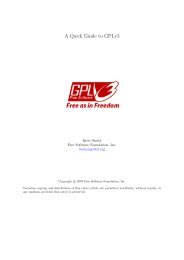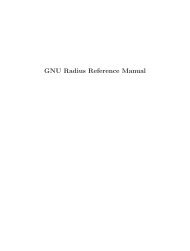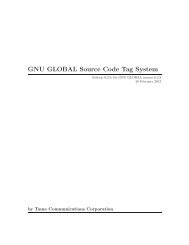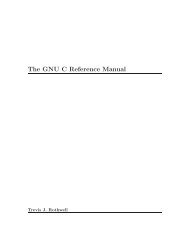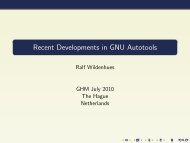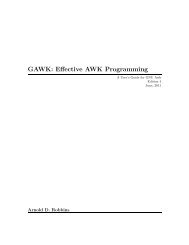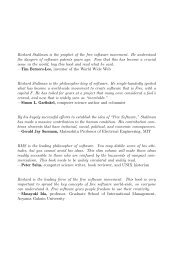by Trent A. Fisher and Werner Lemberg - The GNU Operating System
by Trent A. Fisher and Werner Lemberg - The GNU Operating System
by Trent A. Fisher and Werner Lemberg - The GNU Operating System
Create successful ePaper yourself
Turn your PDF publications into a flip-book with our unique Google optimized e-Paper software.
26 <strong>The</strong> <strong>GNU</strong> Troff Manual<br />
specified <strong>by</strong> the PD macro. <strong>The</strong> font size <strong>and</strong> shape are reset to the<br />
default value (10 pt roman if no ‘-rS’ option is given on the comm<strong>and</strong><br />
line). Finally, the current left margin <strong>and</strong> the indentation is restored.<br />
.IP [designator [nnn]]<br />
[Macro]<br />
Set up an indented paragraph, using designator as a tag to mark its<br />
beginning. <strong>The</strong> indentation is set to nnn if that argument is supplied<br />
(default unit is ‘n’), otherwise it is set to the previous indentation value<br />
specified with TP, IP, or HP (or the default value if none of them have been<br />
used yet). Font size <strong>and</strong> face of the paragraph (but not the designator)<br />
are reset to their default values.<br />
To start an indented paragraph with a particular indentation but without<br />
a designator, use ‘""’ (two double quotes) as the first argument of IP.<br />
For example, to start a paragraph with bullets as the designator <strong>and</strong> 4 en<br />
indentation, write<br />
.IP \(bu 4<br />
.HP [nnn]<br />
[Macro]<br />
Set up a paragraph with hanging left indentation. <strong>The</strong> indentation is set<br />
to nnn if that argument is supplied (default unit is ‘n’), otherwise it is<br />
set to the previous indentation value specified with TP, IP, or HP (or the<br />
default value if non of them have been used yet). Font size <strong>and</strong> face are<br />
reset to their default values.<br />
.RS [nnn]<br />
[Macro]<br />
Move the left margin to the right <strong>by</strong> the value nnn if specified (default<br />
unit is ‘n’); otherwise it is set to the previous indentation value specified<br />
with TP, IP, or HP (or to the default value if none of them have been used<br />
yet). <strong>The</strong> indentation value is then set to the default.<br />
Calls to the RS macro can be nested.<br />
.RE [nnn]<br />
[Macro]<br />
Move the left margin back to level nnn, restoring the previous left margin.<br />
If no argument is given, it moves one level back. <strong>The</strong> first level (i.e., no<br />
call to RS yet) has number 1, <strong>and</strong> each call to RS increases the level <strong>by</strong> 1.<br />
To summarize, the following macros cause a line break with the insertion<br />
of vertical space (which amount can be changed with the PD macro): SH, SS,<br />
TP, LP (PP, P), IP, <strong>and</strong> HP.<br />
<strong>The</strong> macros RS <strong>and</strong> RE also cause a break but do not insert vertical space.<br />
Finally, the macros SH, SS, LP (PP, P), <strong>and</strong> RS reset the indentation to its<br />
default value.<br />
4.1.3 Macros to set fonts<br />
<strong>The</strong> st<strong>and</strong>ard font is roman; the default text size is 10 point. If comm<strong>and</strong><br />
line option ‘-rS=n’ is given, use n pt as the default text size.





